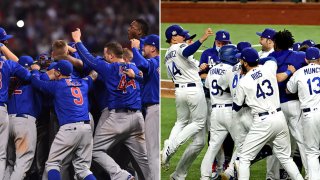
Cubs, Dodgers: Two championships passing in the night originally appeared on NBC Sports Chicago
GLENDALE, Ariz. — On a clear fall night in 2016 at Wrigley Field, young Cubs pitcher Kyle Hendricks out-pitched Clayton Kershaw to beat the Dodgers and send the Cubs to their first World Series in 71 years.
A glimpse of where the two franchises have gone since then showed up in the bottom of the first inning of Thursday night’s spring training game between the teams.
Leading off for the Dodgers was Mookie Betts, the superstar outfielder the Dodgers acquired in a salary-dump trade from the Red Sox a year ago, then signed to a $365 million extension.
Facing Betts for the Cubs was Trevor Williams, a right-hander designated for assignment by the last-place Pirates in November and signed by the Cubs two months later for $2.5 million to backfill for rotation losses during a winter spree of payroll cutting.
Not that Williams won’t perfect that new version of a slider he’s working on in the Cubs’ pitch lab and pay off for the Cubs with a season that looks more like his 2018 (3.11 ERA in 31 starts) than his 2020 (6.18 in 11).
In fact, Williams struck out Betts looking with a slider to start the first inning and then struck him out again swinging at a fastball to end the second of two innings he pitched Thursday.
But barely four months after Betts and the Dodgers won the World Series and barely two after the Cubs dumped the remaining $60 million of Cy Young runner-up Yu Darvish’s contract in a trade to San Diego, this fourth game of spring training might as well have been a seven-inning reminder of all the questions piling up around the Cubs since that 2016 October.
Mostly this question: What the hell happened?
Wasn’t it the Cubs that were supposed to be built for “sustained success”? Wasn’t it the Cubs who were supposed to create the “player development machine” that would produce the young talent pipeline that would leave the big-revenue team enough dough to pay Mookie Betts or DJ LeMahieu (don’t get me started) or anyone else they needed to keep the World Series train rolling?
Feeling out of the loop? We'll catch you up on the Chicago news you need to know. Sign up for the weekly Chicago Catch-Up newsletter.
How did the Dodgers become all those things Theo Epstein and Jed Hoyer — and the Ricketts ownership before them — promised the Cubs would become?
For all the Cubs nostalgia and rightful credit the brass and player core get for the six-year run that is truly historic for the franchise, every glance at the Dodgers during the same stretch is an exercise in rubbing the Cubs faces in what the plan was supposed to look like.
That has never been the case more than now during this stretch more than now, with the Cubs in a roster transition involving cost-cutting and opening an underdog spring training with World Series heroes Kris Bryant, Javy Baez and Anthony Rizzo all pending free agents.
Compare that to the Dodgers, who just played in their third World Series in four years, then re-signed heart-and-soul free agent third baseman Justin Turner and added Cy Young free agent Trevor Bauer, in the middle of a pandemic-suppressed economy, to a deal that makes Bauer the highest-paid Dodger in 2021.
The Dodgers remain the favorites to win a ninth consecutive National League West title and another World Series championship despite the most aggressive offseason in baseball happening just a few miles down the road with the division-rival Padres.
The Cubs?
They beat the Dodgers in one game during the 2017 National League Championship Series and haven’t won a playoff game since — despite exceeding the luxury tax payroll thresholds each of the past two seasons.
Now they’re going to try it again, with Hoyer at the top of the operation, and Epstein on to his next career chapter. Maybe young infielder Nico Hoerner — already off to a torrid start this spring after reshaping his body in the offseason — will be at the heart of the next core.
Maybe rookie Adbert Alzolay and prospect Brailyn Marquez will open an actual pitching pipeline from the system.
For now, nights like Thursday are reminders of what could have been, if not what should have been — certainly of what was promised — for the Cubs.
“The competition just became stronger. Not that we were weaker,” said reliever Pedro Strop, who was a big part of the Cubs’ most successful years and returns to the bullpen this year after leaving for a year as a free agent.
With little to no big-league pitching to show for the last nine years of player development, the Cubs kept spending big on pitching to stay competitive, as their homegrown hitters got more expensive through arbitration — providing less and less impact for an impact-level payroll.
By contrast, the Dodgers’ playoff rotation last October was entirely homegrown, including two rookies who made NLCS starts.
That goes a long way toward sustained success.
And they didn’t even have to tank to catch the Cubs in 2017 — and to widen the margin ever since.
Talk about rubbing the Cubs’ faces in their own plan.




